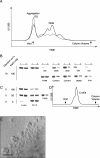A high-throughput method for membrane protein solubility screening: the ultracentrifugation dispersity sedimentation assay
- PMID: 17567744
- PMCID: PMC2206705
- DOI: 10.1110/ps.072759907
A high-throughput method for membrane protein solubility screening: the ultracentrifugation dispersity sedimentation assay
Erratum in
- Protein Sci. 2007 Dec;16(12):2775. Postis, Vincent [added]; Xia, Xiaobing [added]
Abstract
One key to successful crystallization of membrane proteins is the identification of detergents that maintain the protein in a soluble, monodispersed state. Because of their hydrophobic nature, membrane proteins are particularly prone to forming insoluble aggregates over time. This nonspecific aggregation of the molecules reduces the likelihood of the regular association of the protein molecules essential for crystal lattice formation. Critical buffer components affecting the aggregation of membrane proteins include detergent choice, salt concentration, and presence of glycerol. The optimization of these parameters is often a time- and protein-consuming process. Here we describe a novel ultracentrifugation dispersity sedimentation (UDS) assay in which ultracentrifugation of very small (5 microL) volumes of purified, soluble membrane protein is combined with SDS-PAGE analysis to rapidly assess the degree of protein aggregation. The results from the UDS method correlate very well with established methods like size-exclusion chromatography (SEC), while consuming considerably less protein. In addition, the UDS method allows rapid screening of detergents for membrane protein crystallization in a fraction of the time required by SEC. Here we use the UDS method in the identification of suitable detergents and buffer compositions for the crystallization of three recombinant prokaryotic membrane proteins. The implications of our results for membrane protein crystallization prescreening are discussed.
Figures




Similar articles
-
NMR spectroscopic and analytical ultracentrifuge analysis of membrane protein detergent complexes.BMC Struct Biol. 2007 Nov 8;7:74. doi: 10.1186/1472-6807-7-74. BMC Struct Biol. 2007. PMID: 17988403 Free PMC article.
-
Sedimentation equilibrium of detergent-solubilized membrane proteins in the preparative ultracentrifuge.Anal Biochem. 1993 Feb 1;208(2):306-10. doi: 10.1006/abio.1993.1051. Anal Biochem. 1993. PMID: 8452225
-
Gel chromatography and analytical ultracentrifugation to determine the extent of detergent binding and aggregation, and Stokes radius of membrane proteins using sarcoplasmic reticulum Ca2+-ATPase as an example.Nat Protoc. 2008;3(11):1782-95. doi: 10.1038/nprot.2008.177. Nat Protoc. 2008. PMID: 18974737
-
Sedimentation velocity to characterize surfactants and solubilized membrane proteins.Methods. 2011 May;54(1):56-66. doi: 10.1016/j.ymeth.2010.11.003. Epub 2010 Nov 26. Methods. 2011. PMID: 21112401 Review.
-
Detergent quantification in membrane protein samples and its application to crystallization experiments.Amino Acids. 2013 Dec;45(6):1293-302. doi: 10.1007/s00726-013-1600-3. Epub 2013 Oct 9. Amino Acids. 2013. PMID: 24105076 Review.
Cited by
-
A structural biology approach to understand human lymphatic filarial infection.PLoS Negl Trop Dis. 2014 Feb 6;8(2):e2662. doi: 10.1371/journal.pntd.0002662. eCollection 2014 Feb. PLoS Negl Trop Dis. 2014. PMID: 24516678 Free PMC article.
-
ATR-FTIR spectroscopy and spectroscopic imaging to investigate the behaviour of proteins subjected to freeze-thaw cycles in droplets, wells, and under flow.Analyst. 2021 May 7;146(9):2902-2909. doi: 10.1039/d1an00087j. Epub 2021 Mar 16. Analyst. 2021. PMID: 33724288 Free PMC article.
-
ATR-FTIR spectroscopy and spectroscopic imaging for the analysis of biopharmaceuticals.Spectrochim Acta A Mol Biomol Spectrosc. 2020 Nov 5;241:118636. doi: 10.1016/j.saa.2020.118636. Epub 2020 Jun 22. Spectrochim Acta A Mol Biomol Spectrosc. 2020. PMID: 32610215 Free PMC article. Review.
-
Overcoming the challenges of membrane protein crystallography.Curr Opin Struct Biol. 2008 Oct;18(5):581-6. doi: 10.1016/j.sbi.2008.07.001. Epub 2008 Aug 11. Curr Opin Struct Biol. 2008. PMID: 18674618 Free PMC article. Review.
-
Effective critical micellar concentration of a zwitterionic detergent: a fluorimetric study on n-dodecyl phosphocholine.J Fluoresc. 2010 Jan;20(1):191-6. doi: 10.1007/s10895-009-0537-0. Epub 2009 Sep 16. J Fluoresc. 2010. PMID: 19756982
References
-
- Byrne B. and Jormakka, M. 2006. Solubilization and purification of membrane proteins. In Structural genomics on membrane proteins (ed. K.H. Lundstrom), pp. 179–198. Taylor and Francis, New York.
-
- Chang G., Spencer, R.H., Lee, A.T., Barclay, M.T., and Rees, D.C. 1998. Structure of the MscL homolog from Mycobacterium tuberculosis: A gated mechanosensitive ion channel. Science 282: 2220–2226. - PubMed
-
- D'Arcy A. 1994. Crystallizing proteins—A rational approach? Acta Crystallogr. D Biol. Crystallogr. 50: 469–471. - PubMed
Publication types
MeSH terms
Substances
Grants and funding
LinkOut - more resources
Full Text Sources
Other Literature Sources

